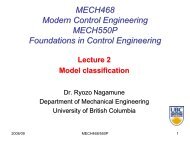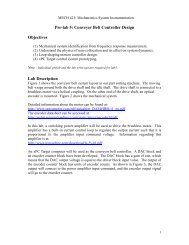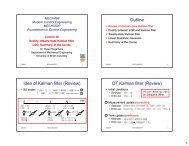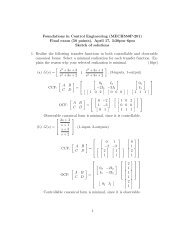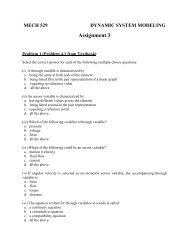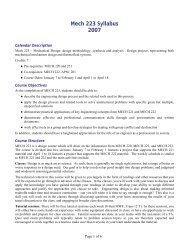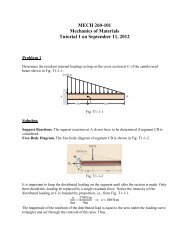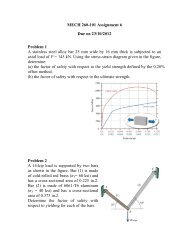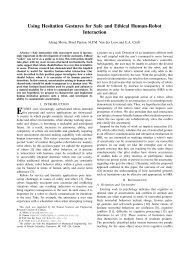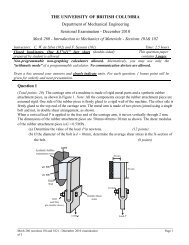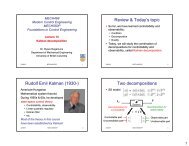Dynamic System Modeling Presentation Part 1 - UBC Mechanical ...
Dynamic System Modeling Presentation Part 1 - UBC Mechanical ...
Dynamic System Modeling Presentation Part 1 - UBC Mechanical ...
You also want an ePaper? Increase the reach of your titles
YUMPU automatically turns print PDFs into web optimized ePapers that Google loves.
MECH 529<br />
<strong>Dynamic</strong> <strong>System</strong> <strong>Modeling</strong><br />
<strong>Presentation</strong> <strong>Part</strong> 1<br />
Dr. Clarence W. de Silva, P.Eng.<br />
Professor of <strong>Mechanical</strong> Engineering<br />
The University of British Columbia<br />
e-mail: desilva@mech.ubc.ca<br />
http://www.mech.ubc.ca/~ial<br />
©<br />
C.W. de Silva
MECH 469/529: <strong>Modeling</strong> of <strong>Dynamic</strong> <strong>System</strong>s; 3 Credits, 1st Term, 2012/13<br />
Tuesdays and Thursdays (MacLeod 220), 5:00 to 6:30pm<br />
Course Web Site: www.mech.ubc.ca/~ial (Courses MECH 529)<br />
Instructor: Dr. Clarence W. de Silva, Professor<br />
Office: CEME 2071; Telephone: 604-822-6291; e-mail: desilva@mech.ubc.ca<br />
Teaching Assistant: Mr. Shawn Zhang<br />
Office: ICICS 065; Tel: 604-822-4850; e-mail: yfzhang83@gmail.com<br />
Prerequisites: This course is particularly suitable for senior undergraduate and entry-level<br />
graduate engineering students. There are no specific prerequisites. But, students who have<br />
already taken introductory courses in circuit analysis, dynamics, fluid mechanics, and<br />
thermodynamics (or energy conversion) will be at an advantage.<br />
Objectives<br />
The course deals with the methodology of understanding and modeling a physical engineering<br />
system. The primary emphasis will be on the engineering problem of modeling rather than the<br />
applied mathematics of response analysis (and simulation) once a model is available.<br />
The students will learn to understand and model mechanical, thermal, fluid and electrical<br />
systems in a systematic and unified/integrated manner. For example, identification of lumped<br />
elements such as sources, capacitors, inductors, and resistors in different types of physical<br />
systems will be studied. Analogies among the four main types of systems (mechanical, thermal,<br />
fluid and electrical) will be presented in terms of these basic lumped elements and in terms of the<br />
system variables. Concepts of through and across variables, and flow and effort variables will be<br />
introduced. Multi-domain (or mixed) systems which consist of two or more of the basic system<br />
types will be considered as well.<br />
Tools of modeling and model-representation such as linear graphs and block diagrams will be<br />
discussed. Important considerations of input, output, causality, and system order will be examined.<br />
Thevenin and Norton equivalent circuits and their application to mechanical systems using linear<br />
graphs will be studied. A brief overview of response analysis will be given.<br />
Textbook: de Silva, C.W., <strong>Modeling</strong> and Control of Engineering <strong>System</strong>s, Taylor & Francis/CRC Press,<br />
Boca Raton, FL, 2009.
MECH 469/529 COURSE LAYOUT<br />
Week Starts Topic Read<br />
1 Sept 06 Introduction Chapter 1<br />
2 Sept 11 Model Types, Analogies Chapter 2<br />
3 Sept 18 Electrical <strong>System</strong>s Chapter 2<br />
4 Sept 25 Fluid <strong>System</strong>s Chapter 2<br />
5 Oct 02 Thermal <strong>System</strong>s Chapter 2<br />
6 Oct 09 State-space Models Chapter 2<br />
7 Oct 16 Model Linearization Chapter 3<br />
8 Oct 23 Linear Graphs Chapter 4<br />
9 Oct 30 State Models from Linear Graphs Chapter 4<br />
10 Nov 06<br />
Thursday, Nov 08:<br />
Transfer Function Models<br />
Intermediate Exam<br />
Chapter 5<br />
11 Nov 13 Thevenin/Norton Equivalent<br />
Circuits; Linear Graph Reduction<br />
Chapter 5<br />
12 Nov 20 Simulation Block Diagrams; Chapter 6<br />
13 Nov 27<br />
Thursday, Nov 29:<br />
Response Analysis and Simulation<br />
Advanced Topics; <strong>Modeling</strong><br />
Applications<br />
Final Take-home Exam Given Out<br />
Monday, Dec 03: Final Take-home Exam Due<br />
Grade Composition<br />
Intermediate examination 40%<br />
Attendance 10%<br />
Final Exam (different for MECH 469 and MECH 529) 50%<br />
Total 100%
Course Objectives<br />
Methodology of understanding and modeling a physical<br />
engineering dynamic system.<br />
Primary Emphasis: Procedure of analytical modeling<br />
Secondary: Response analysis and simulation once modeled<br />
<strong>System</strong>atic, Unified Approach to <strong>Modeling</strong> of:<br />
mechanical, thermal, fluid, and electrical, systems<br />
Analogies among these four types of systems<br />
Multi-domain (Mixed) <strong>System</strong>s: Have two or more basic<br />
system types<br />
Identification of Lumped Elements (sources, capacitors,<br />
inductors, and resistors)<br />
Through and Across Variables; Flow and Effort Variables<br />
<strong>System</strong>atic Tools of <strong>Modeling</strong>: Linear graphs, block diagrams<br />
Important Considerations: Input, output, causality, system<br />
order<br />
Response Analysis and Simulation
Course Learning Activities<br />
Power-point presentations will be posted on the web site<br />
Assignments and solutions will be posted (not graded)<br />
Past Exams and solutions will be posted<br />
Office Hours: Mondays, 2:00 to 3:00 p.m. in CEME 2071<br />
TA Office Hours: Thursdays, 3:30 to 4:30 p.m. in ICICS 065<br />
November 08, 2012 (Thursday):<br />
Intermediate Examination (In Class)<br />
November 29, 2012 (Thursday):<br />
Final Take-home Examination Given Out<br />
December 03, 2012 (Monday):<br />
Final Take-home Exam Due in Mech Office
Analytical Model Example:<br />
Automated Gudeway Transit <strong>System</strong>
Analytical Model Example:<br />
Automated Gudeway Transit <strong>System</strong>
Analytical Model Example:<br />
Computer Hard Disk Drive (HDD)
<strong>Dynamic</strong> <strong>System</strong><br />
Environment<br />
<strong>Dynamic</strong> <strong>System</strong><br />
(State Variables,<br />
<strong>System</strong> Parameters)<br />
Outputs/<br />
Responses<br />
Inputs/<br />
Excitations<br />
<strong>System</strong><br />
Boundary<br />
Note: Rates of Changes of Outputs/State Variables are Not Negligible<br />
(These rates are needed in the system representation)
TERMINOLOGY<br />
<strong>System</strong>: Collection of interacting components of interest,<br />
demarcated by a system boundary<br />
<strong>Dynamic</strong> <strong>System</strong>: Rates of changes of response/state variables<br />
(about some operating condition) cannot be neglected<br />
Plant or Process: <strong>System</strong> to be controlled<br />
Inputs: Excitations (known, unknown) to the system<br />
Outputs: Responses of the system<br />
State Variables: Completely identify the “dynamic” state of system<br />
Note: If state variables at one state and inputs up to a future state<br />
are known, the future state can be completely determined<br />
Control <strong>System</strong>: Plant + controller, at least (May include sensors,<br />
signal conditioning, etc.)
Examples of <strong>Dynamic</strong> <strong>System</strong>s<br />
<strong>System</strong> Typical Input Typical Outputs<br />
Human body<br />
Neuroelectric<br />
pulses<br />
Muscle contraction,<br />
body movements<br />
Company Information Decisions,<br />
finished products<br />
Power plant Fuel rate Electric power,<br />
pollution rate<br />
Automobile Steering wheel<br />
movement<br />
Front wheel turn,<br />
direction of heading<br />
Robot Voltage to joint Joint motions,<br />
motor<br />
effector motion
A DYNAMIC SYSTEM EXAMPLE:<br />
A VISION-BASED WAFER INSPECTION Control <strong>System</strong>
A DYNAMIC SYSTEM EXAMPLE:<br />
A MACHINE TOOL WHICH NEEDS ACCURATE CONTROL
It is a representation of a system<br />
<strong>Dynamic</strong> Model<br />
Useful in analysis, simulation, design, modification, and control<br />
An engineering (e.g., Mechatronic) physical system consists of a<br />
mixture of different types of components<br />
An engineering (e.g., Mechatronic) system is typically a multidomain<br />
(mixed) system<br />
Integrated and unified development of model is desirable (i.e., all<br />
domains are modeled together using similar approaches)<br />
Use analogous procedures to model all components (in analytical<br />
modeling)<br />
Analogies exist in mechanical, electrical, fluid, and thermal<br />
systems
MODEL TYPES<br />
Model: A representation of a system.<br />
Types of Models:<br />
1. Physical Models (Prototypes)<br />
2. Analytical Models<br />
3. Computer (Numerical) Models (Data Tables, Curves, Programs,<br />
Files, etc.)<br />
4. Experimental Models (use input/output experimental data for<br />
model “identification”)<br />
Note:<br />
<strong>Dynamic</strong> <strong>System</strong>: Response variables are functions of time,<br />
with non-negligible rates of changes about an operating condition.
MODEL COMPLEXITY<br />
• Universal Model (which considers all aspects of the system) is<br />
unrealistic<br />
E.g.: An automobile model that represents ride quality, energy<br />
consumption, traction characteristics, handling, structural<br />
strength, capacity, load characteristics, cost, safety, etc. is not<br />
very practical<br />
• Model may address a few specific aspects of<br />
interest/application<br />
• Model should be as simple as possible (Approximate<br />
modeling, model reduction, etc. are applicable here)
ADVANTAGES OF ANALYTICAL MODELS<br />
OVER PHYSICAL MODELS<br />
• Modern, high-capacity, high-speed computers can accommodate<br />
complex analytical models<br />
• Models can be modified quickly, conveniently, and high speed at low<br />
cost<br />
• High flexibility of making structural and parametric changes<br />
• Naturally amenable to computer simulations<br />
• Can be integrated with computer/numerical/experimental models<br />
• Can be done well before a prototype is built (and can be instrumental<br />
in deciding whether to prototype)
ANALYTICAL MODEL TYPES<br />
• Nonlinear: Nonlinear differential equations (principle of superposition does not hold)<br />
• Linear: Linear differential equations (principle of superposition holds)<br />
• Distributed (Continuous)-parameter: <strong>Part</strong>ial differential equations (Dependent variables are<br />
functions of time and space)<br />
• Lumped-parameter: Ordinary differential equations (Dependent variables are functions of<br />
time, not space)<br />
• Time-varying (Non-stationary, Non-autonomous): Differential equations with time-varying<br />
coefficients (Model parameters vary with time)<br />
• Time-invariant (Stationary, Autonomous): Differential equations with constant coefficients<br />
(Model parameters are constant)<br />
• Random (Stochastic): Stochastic differential equations (Variables and/or parameters are<br />
governed by probability distributions)<br />
• Deterministic: Non-stochastic differential equations<br />
• Continuous-time: Differential equations (Time variable is continuously defined)<br />
• Discrete-time: Difference equations (Time variable is defined as discrete values at a sequence<br />
of time points)
Lumped Model of a Distributed <strong>System</strong>: A Heavy Spring<br />
Note: Mass (and flexibility) are distributed throughout the spring (not<br />
at a few discrete points)
Lumped Model of a Distributed <strong>System</strong>: A Heavy Spring<br />
m s = mass of spring; k = stiffness of spring; l = length of spring<br />
One end fixed and the other end moving at velocity v<br />
Kinetic Energy Equivalence<br />
m<br />
Local speed of element δx = x s<br />
v. Element mass = δ x<br />
l<br />
<br />
Element kinetic energy KE =<br />
l<br />
l<br />
1 m x s x(<br />
v)<br />
2 l<br />
δ l<br />
2<br />
1 ms<br />
x 1 msv<br />
2 1 ms<br />
As δx → dx, Total KE = ∫ dx(<br />
v)<br />
= x dx<br />
3<br />
2 l l 2 l<br />
∫ =<br />
2 3<br />
0<br />
2<br />
l<br />
2<br />
2 v<br />
Equivalent lumped mass concentrated at free end = 1 × spring mass<br />
3<br />
Assumption: Conditions are uniform along the spring.<br />
0
Lumped Model of a Distributed <strong>System</strong>: A Heavy Spring<br />
Lumped-parameter Approximation for an Oscillator with Heavy Spring
STEPS OF MODEL (ANALYTICAL) DEVELOPMENT<br />
1. Identify system of interest (purpose, boundary)<br />
2. Identify/specify variables of interest (excitations/inputs, responses/outputs, etc.)<br />
3. Approximate various segments (processes, phenomena) by ideal elements, suitably<br />
interconnected.<br />
4. Draw a free-body or circuit diagram (or linear graph), with suitably isolated<br />
components.<br />
(a)Write constitutive equations (physical laws) for elements.<br />
(b)Write continuity (or conservation) equations for<br />
through variables (equilibrium of forces at joints; current balance at nodes, etc.)<br />
(c)Write compatibility equations for across (potential or path) variables (loop<br />
equations for velocities—geometric connectivity; voltages—potential balance)<br />
(d)Eliminate auxiliary (unwanted) variables<br />
5. Express boundary conditions and initial conditions using system variables.




